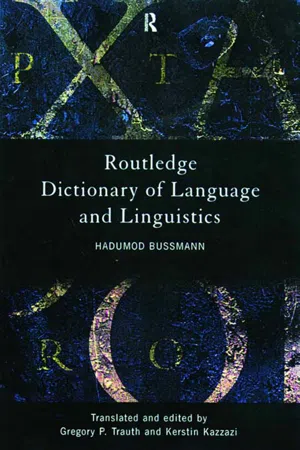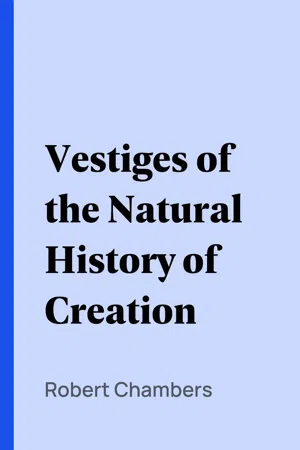Languages & Linguistics
Polysynthetic Languages
Polysynthetic languages are characterized by the ability to form complex words through the addition of multiple affixes, incorporating various grammatical and lexical elements into a single word. These languages often exhibit extensive word formation processes, allowing for the expression of complex ideas within a single word. Polysynthetic languages are found in various indigenous languages, such as Inuktitut and Mohawk.
Written by Perlego with AI-assistance
4 Key excerpts on "Polysynthetic Languages"
- eBook - ePub
- Hadumod Bussmann, Kerstin Kazzazi, Gregory Trauth, Kerstin Kazzazi, Gregory Trauth(Authors)
- 2006(Publication Date)
- Routledge(Publisher)
isolating language), such as Classical Chinese, the grammatical relations between words in a sentence are expressed by independent syntactic form elements (e.g. prepositions), while in synthetic languages they are expressed by dependent morphological units (see Schlegel 1818). In the synthetic languages, Schlegel distinguishes between agglutinating languages, in which grammatical and lexical morphemes with simple semantic components are simply affixed to each other (e.g. Turkish), and inflectional languages, whose words cannot be analyzed into single morphemes with simple semantic meaning and which sometimes demonstrate phenomena such as root or stem alternation (e.g. Sanskrit). Humboldt (1836) added the term ‘Polysynthetic Languages,’ (⇒ polysynthesis) in which a word often combines several word stems with very specific semantic meaning (e.g. Iroquoian) (also ⇒ incorporating language). In this early stage of language typology, value judgments were also attached to each type: the richness of forms in the inflectional languages was considered a sign of greater development, while the isolating and agglutinating languages were seen as less developed stages on their way to becoming inflectional languages. For a history of the research on language typology, see Haarman (1976). The main objections against this traditional, primarily morphological, typology are based on the lack of theoretical agreement about the nature of the elements (such as syllable, morpheme, word) and properties (such as intonation, concatenation - eBook - ePub
- Robert Chambers(Author)
- 2004(Publication Date)
- Perlego(Publisher)
all of them features in common, proving them to constitute a group by themselves, without any regard to the very different degrees of civilization which these nations had attained at the time of the discovery. The common resemblance is in the grammatical structure as well as in words, and the grammatical structure of this family is of a very peculiar and complicated kind. The general character in this respect has caused the term Polysynthetic to be applied to the American languages. A long many-syllabled word is used by the rude Algonquins and Delawares to express a whole sentence: for example, a woman of the latter nation, playing with a little dog or cat, would perhaps be heard saying, “kuligatschis,” meaning, “give me your pretty little paw;” the word, on examination, is found to be made up in this manner: k, the second personal pronoun; uli, part of the word wulet, pretty; gat, part of the word wichgat, signifying a leg or paw; schis, conveying the idea of littleness. In the same tongue, a youth is called pilape, a word compounded from the first part of pilsit, innocent, and the latter part of lenape, a man. Thus, it will be observed, a number of parts of words are taken and thrown together, by a process which has been happily termed agglutination, so as to form one word, conveying a complicated idea. There is also an elaborate system of inflection; in nouns, for instance, there is one kind of inflection to express the presence or absence of vitality, and another to express number. The genius of the language has been described as accumulative: it “tends rather to add syllables or letters, making - David Hornsby(Author)
- 2014(Publication Date)
- Teach Yourself(Publisher)
Languages differ more in morphology than in syntax. The variety is so great that no simple scheme will classify languages as to their morphology. One such scheme distinguishes analytic languages, which use few bound forms, from synthetic, which use many. At one extreme is a completely analytic language, like modern Chinese, where each word is a one-syllable morpheme or compound word or phrase-word; at the other, a highly synthetic language like Eskimo, which unites long strings into single words (…) This distinction, however, except for cases at the former extreme, is relative; any one language may be in some respects more analytic, but in other respects more synthetic, than some other language.’(Bloomfield 1933: 207)Key idea: Morphology: the study of word structureDerivational morphology is concerned with the creation of new words.Inflectional morphology involves the marking of grammatical categories (for example number, tense or gender).The distinction between morphology and syntax as sketched above would seem to presuppose a clear definition of the term word but, as we shall see, ‘words’ prove problematical on a number of levels. If asked ‘how many words there on this page?’, we’d probably count the number of items with blank spaces either side (would contractions like that ‘we’d’ in the previous clause count as one word or two?) and ignore the fact that some words (e.g. ‘the’) are used more than once. But if asked instead how many words there are in the Oxford English Dictionary, or how many words of Spanish we know, our criteria would change: ‘words’ in this case would imply different words as cited independently in the dictionary, and would not include inflected forms predictable by rule, i.e. we would treat dog/dogs or read/reads/reading as the same ‘word’ in each case. i.e. dog+s dogs, or read+ing reading- eBook - ePub
Applying Linguistics in the Classroom
A Sociocultural Approach
- Aria Razfar, Joseph C. Rumenapp(Authors)
- 2013(Publication Date)
- Routledge(Publisher)
Think of the word “cat.” When we teach our students to make this word plural we tell them the English rule is to add an “-s” to make “cats.” This basic rule is an example of how English combines two morphemes into one word. The first morpheme is “cat” which we, in English, identify as a noun. The second is the plural marker, which we can add to most nouns to make plural. This constitutes a morphological rule. As we have said previously, linguistic rules are different from prescriptive rules found in school-based grammar books. For linguists, it is a rule because we can use it to describe how a language works, even though the rule is not always true. We could call English, then, a fusional language in that many words can be made up of multiple morphemes, or they are “fused” together. Not all languages have a morphological structure like English. In some languages, like Mandarin, almost every word is only a single morpheme. We might call a language like this isolating. In English we would change the word to show past tense, but in Mandarin the word doesn’t change at all. Another word is simply added to the sentence. The morphological rules in isolating languages are quite simple compared to English because tense, case, aspect, number, and other grammatical concepts are understood in the context of the sentence or conversation, and not in the word itself. Another category of languages may be called agglutinating or polysynthetic. Similarly to fusional languages, agglutinating languages combine different morphemes to form what we would call a word. However, these words sometimes may contain so much information that it would be similar to an entire sentence in English. Many Native American languages are polysynthetic, including Inuit languages. For example, in one Inuit language, “katimaqatigijunnaqinnga?” roughly translates to “Can I meet with you?” (Pirurvik Centre, 2012)
Index pages curate the most relevant extracts from our library of academic textbooks. They’ve been created using an in-house natural language model (NLM), each adding context and meaning to key research topics.
Explore more topic indexes
Explore more topic indexes
1 of 6
Explore more topic indexes
1 of 4



